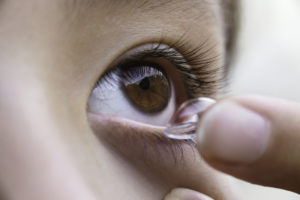August 1, 2020
By Dwight Akerman, OD, MBA, FAAO, FBCLA
Chief Medical Editor, Review of Myopia Management
 Often clinicians will ask: “Which is more efficacious in controlling axial length in myopic children, topical low-dose atropine or orthokeratology?” Researchers from China aimed to answer this question.
Often clinicians will ask: “Which is more efficacious in controlling axial length in myopic children, topical low-dose atropine or orthokeratology?” Researchers from China aimed to answer this question.
The objective of their study was to compare the efficacies of 0.02 percent atropine eye drops and orthokeratology to control axial length (AL) elongation in children with myopia. All of the 247 children enrolled in this historical control study had myopia and had been administered 0.02 percent atropine (n = 142) or had undergone orthokeratology from an earlier study (n = 105, control group). Data on AL and other parameters were recorded at baseline and after one and two years of treatment.
Multivariate regression analyses showed that the AL elongation was significantly faster in the 0.02 percent atropine group than in the orthokeratology group. In multivariate regression analyses, younger age and shorter baseline AL were associated with a rapid AL elongation in the 0.02 percent atropine group, while younger age, lower baseline spherical equivalent refractive error (SER) and shorter baseline AL were associated with a greater increase in AL in the orthokeratology group. Faster AL elongation was found in the 0.02 percent atropine group compared with the orthokeratology group at higher baseline spherical equivalent refractive error.
Chinese researchers determined that orthokeratology seems to be a better method for controlling axial length elongation compared with 0.02 percent atropine in children who had higher myopia over a treatment period of two years. Since historical control studies introduce potential bias, the results of this study must be validated with a randomized controlled trial (RCT).
Abstract
Comparison of Administration of 0.02 percent Atropine and Orthokeratology for Myopia Control
Lyu Y, Ji N, Fu AC, Wang WQ, Wei L, Qin J, Zhao BX
OBJECTIVE: To compare the efficacies of 0.02 percent atropine eye drops and orthokeratology to control axial length (AL) elongation in children with myopia.
METHODS: In this historical control study, 247 children with myopia who were administered 0.02 percent atropine (n=142) or who underwent orthokeratology from an earlier study (n=105, control group) were enrolled. Data on AL and other baseline parameters were recorded at baseline and after one and two years of treatment.
RESULTS: The mean changes in AL in the first and second years of treatment were 0.30±0.21 mm and 0.28±0.20 mm, respectively, in the 0.02 percent atropine group, and 0.16±0.20 mm and 0.20±0.16 mm, respectively, in the orthokeratology group. Axial length elongations after two years of treatment were 0.58±0.35 mm and 0.36±0.30 mm (P=0.007) in the 0.02 percent atropine and orthokeratology groups, respectively. Multivariate regression analyses showed that the AL elongation was significantly faster in the 0.02 percent atropine group than in the orthokeratology group (β=0.18, P=0.009). In multivariate regression analyses, younger age and shorter baseline AL were associated with a rapid AL elongation in the 0.02 percent atropine group (βage=-0.04, P=0.01; βAL=-0.17, P=0.03), while younger age, lower baseline spherical equivalent refractive error (SER), and shorter baseline AL were associated with a greater increase in AL in the orthokeratology group (βage=-0.03, P=0.04; βSER=0.06, P=0.03; βAL=-0.11, P=0.009). Faster AL elongation was found in the 0.02 percent atropine group compared with the orthokeratology group at higher baseline SER (P=0.04, interaction test).
CONCLUSION: Within the limits of this study design, orthokeratology seems to be a better method for controlling AL elongation compared with administration of 0.02 percent atropine in children with higher myopia over a treatment period of two years.
Lyu, Y., Ji, N., Fu, A. C., Wang, W. Q., Wei, L., Qin, J., & Zhao, B. X. (2020). Comparison of Administration of 0.02% Atropine and Orthokeratology for Myopia Control. Eye & Contact Lens.
DOI: 10.1097/icl.0000000000000699













